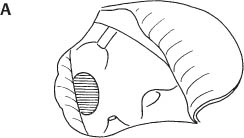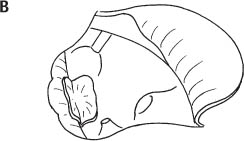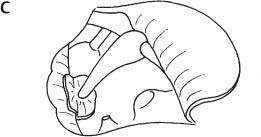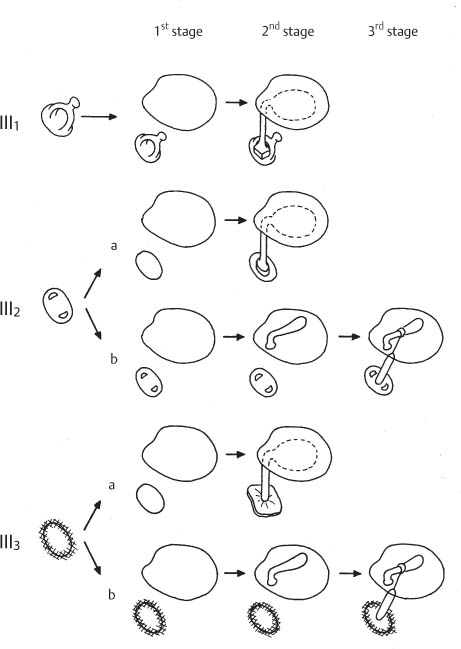Chapter 3 Ossiculoplasty Only a good preoperative classification of the ossicular status will allow a valid postoperative assessment of results. The following classification reflects ossicular defects leading to different functional outcomes. This classification allows a fair comparison of postoperative hearing. Fig. 21 The basic situations in reconstruction of the ossicular chain (ossiculoplasty) can be divided into three groups according to the expected functional result: Basic situation I: malleus and stapes The functional results of ossicular reconstruction in the presence of a mobile intact stapes, the malleus handle, and an intact anterior drum yield, on average, a closure of the air–bone gap to within 10 dB. Basic situation II: malleus and footplate The expected average air–bone gap after reconstruction is within 20 dB. Basic situation III: stapes only This ossicular situation can be subdivided into two groups depending upon the type of operative cavity: a) closed cavity: mobile stapes (III1), mobile footplate (III2), and fixed stapes (III3) b) open cavity: mobile stapes (III4), mobile footplate (III5), and fixed stapes (III6) The expected air–bone gap after reconstruction averages 30 dB for both groups. Only the ossicular reconstruction for the mobile stapes in a closed cavity is considered here. The fixed stapes is handled as for basic situation II2. The open cavities are managed similarly to the closed ones. Incus interposition is the preferred type of reconstruction in basic situation I and consists of placing a reshaped incus between the stapes head and malleus handle. An autologous incus is used whenever possible. As an alternative, an incus made from bio-compatible material such as hydroxyapatite may also be used. Since 1996 our preferred alternative to autograft has been the titanium incus (TI). The incus interposition is carried out in one stage, except when the anterior half of the tympanic membrane is absent. A large anterior perforation destabilizes the malleus handle and eliminates the tension necessary to secure the reconstructed ossicular chain. The incus interposition is performed similarly in open and closed cavities. Fig. 22 a Incus interposition with intact malleus (including malleus head). b Incus interposition with malleus handle only (malleus head removed). Preservation or removal of the malleus head does not influence the final functional result. Incus interposition and tensor tympani tendon d The absence of the tensor tympani tendon compromises the final hearing result because of anterior migration of the malleus handle. This is particularly true in an open cavity where staged surgery is preferred if the tensor tympani tendon is missing or cut. The tensor tympani tendon should never be cut without good reason.
General Considerations
 Basic Situations in Ossiculoplasty
Basic Situations in Ossiculoplasty
Classification of ossicular defects (I, II, III)
Specific Surgical Techniques
 Basic Situation I: Malleus and Stapes Present, Incus Missing
Basic Situation I: Malleus and Stapes Present, Incus Missing
 Incus Interposition
Incus Interposition
Surgical Technique
a) Incus Interposition with Autograft Ossicle
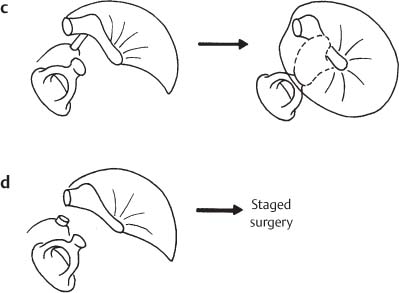
Incus interposition and malleus head
Surgical Highlights |
|
Surgical Steps
Fig. 23A
Missing long process of the incus
Fig. 23B
Removal of the incus
Note rotation of the incus for extraction.
Fig. 23C
Size and inclination of the modified incus
The length of the Fisch microraspatory is 2.5 mm (23-I, 24-I) and usually corresponds to the distance between the stapes head and malleus handle. The position of the microraspatory is very useful in assessing the necessary gap to bridge the defect between both ossicles.
Fig. 23D
Shaping the incus
a A small curved clamp (left hand, 6-I) holds the incus body so that no change of its position is necessary while drilling. A diamond burr is used to remove the long process of the incus and the posterior part of the incus body.
b The articular surface of the incus is carved with a drill to accommodate the malleus handle.
c A notch for the stapes head is drilled in the incus body using a 0.6 and 0.8-mm diamond burr.
d The correct size and inclination of the interposed incus are determined with the Fisch microraspatory.
e The interposed incus should fit tightly between the stapes head and proximal malleus handle.
Fig. 23E
Introduction of the modified incus
The modified incus is picked up with the largest micro-suction tube and placed in contact with the malleus handle caudal to the preserved chorda tympani.
Fig. 23F
Interposition of the modified incus
The modified incus is lateralized and rotated over the stapes head with a 1.5-mm, 45° hook (29-I).
Fig. 23G
Final position of the interposed incus
The incus is firmly attached to the stapes head and proximal malleus handle (just below the lateral process). The chorda tympani runs cranial to the interposed incus and prevents contact between the incus and the surrounding bone (prevention of fixation).
Fig. 23H
Variable inclination of the interposed incus
The distance between the malleus handle and stapes head can vary greatly. Appropriate shaping of the incus is necessary for the stability of the interposed ossicle. Note that the articulation to the malleus is shaped in such a way that the incus body is higher than the malleus handle. This stabilizes the interposed incus better and also affords better contact with the undersurface of the drum. However, the functional results are compromised if the ossicle is placed in a horizontal position as in c. If this situation occurs in an open cavity, it is preferable to use a columella type of reconstruction (e.g., tragal cartilage).
Fig. 23I
Surgical site after repositioning the tympanomeatal flap
The incus lies just distal to the lateral process of the malleus. The proximal position of the interposed incus along the malleus handle increases the stability of the reconstruction because the maximal movements of the malleus handle when swallowing, sneezing, or blowing the nose occur at the umbo.
b) Alternative Technique with Titanium Incus
The TI is used when the autologous incus is not available. There is no danger of fixation by ossification when using a titanium prosthesis in the middle ear. The contact with soft tissues of a titanium pros-thesis depends upon the degree of polishing of its surface.
Fig 23J
Titanium Incus
The TI is shaped in a similar fashion to the autologous incus, with an inclined groove for the malleus on one end and a notch for the stapes on the other. In between there is a hole the same size as a 2.5-mm, 45° hook (60-I). The hook fits securely into the hole and is used for transportation (see Fig. 23L). Hooks of a smaller size cannot be used because they do not fit securely enough into the opening. The TI is available in three sizes of 3-, 4-, and 5-mm lengths (see Prostheses p. 374). The length of each size prosthesis can be modified with the diamond burr if needed (see Fig. 23K).
Fig. 23K
Shaping of the Titanium Incus
The contact surfaces of the notches of the TI for the malleus and stapes should be roughened with the diamond burr because experience has shown that the polished titanium surface does not connect sufficiently well with periosteum or other soft tissues. If the TI is interposed in its original polished state between the stapes and malleus handle, it can become displaced in the course of time. The contact surfaces are roughened with the diamond burr by grasping the prosthesis with special holding forceps (59-I) (a). The fingers cannot be used because drilling on metal produces excessive heat. It is advisable to cool the prosthesis while drilling it. The size and shape of the notch for the stapes can be modified as required with the diamond burr (b).
Fig. 23L
Interposition of the Titanium Incus
The TI is grasped with the 2.5-mm, 45° hook (30-I) and introduced between the malleus and stapes as an autologous incus by placing it in contact with the malleus handle first (see Fig. 23E). Having achieved the proper contact with the malleus, the TI is lateralized with a 1.5-mm, 45° hook (29-I) placed into the notch for the stapes head. The lateralized prosthesis is rotated over the stapes head (see Figs. 23F, G). The preserved chorda tympani runs cranially to the interposed titanium prosthesis, stabilizing its position.
 Basic Situation II: Footplate and Malleus
Basic Situation II: Footplate and Malleus
The ossicular reconstructions for the mobile foot-plate (II1) and fixed footplate (II2) (see Fig. 21) are discussed only for closed cavities because the open cavities are managed in a similar fashion.
 Basic Situation II1: Mobile Footplate and Malleus, Closed Cavity
Basic Situation II1: Mobile Footplate and Malleus, Closed Cavity
Fig. 24
Alternatives for ossiculoplasty in basic situation II1
The alternative techniques for ossiculoplasty in basic situation II1 are:
a Malleo-stapedotomy (MS).
b Spandrel II or FTT.
c Autograft ossicle.
a) Malleo-stapedotomy
Surgical Technique
We have defined malleo-stapedotomy (MS) as the technique of bridging the gap between the malleus handle and footplate with a stapes prosthesis reaching the vestibule through a stapedotomy opening. In the first edition of this book we called it incus replacement with stapedotomy (IRS).
The operation is performed in one stage if the tympanic membrane is intact. A perforated tympanic membrane requires second-stage surgery. The patients selected for MS should not demonstrate signs of tubal dysfunction for 6 to 12 months before surgery. The same 0.4 × 8.5-mm titanium stapes piston (TSP) is used in this procedure as for incusstapedotomy (IS). A shorter prosthesis (0.4 mm × 7 mm) is used in second-stage operations of open cavities. A longer prosthesis (0.4 mm × 10 mm) may be used in anomalous ears. The difference between these prostheses is not only the total length (which is trimmed on a cutting block), but mainly the distance between the loop and the cylinder of the piston: 1.5 mm in the short and 2.5 mm in the long prosthesis (see Middle Ear Prostheses, p. 374).
Surgical Highlights |
|
Fig. 25A
Exposure of the malleus handle
A tympanomeatal flap similar to that used in stapedotomy (see Figs. 107D–G, pp. 226, 227) is elevated, exposing the lateral process and 1 mm of the malleus handle. This exposure eliminates the need to create a tunnel between the malleus handle and drum for introducing and crimping the prosthesis. The figure demonstrates an excessive exposure of the malleus handle. This should be avoided to keep the natural fixation of the drum to the malleus handle intact, which is essential for good functional results. Furthermore, the prosthesis loop should be placed as close as possible to the lateral process of the malleus. Only minimal elevation of the tympanic membrane is necessary for this surgical step (see also Fig. 25H).
Fig. 25B
Determination of the prosthesis length
The malleable measuring rod (37-I) may be used to estimate a) the distance between the lateral surface of the malleus and the center of the footplate and b) the distance between the anterior position of the malleus and the posterior center of the foot-plate.
Fig. 25C
Prosthesis positioned over the footplate
A 0.4-mm titanium stapes prosthesis is trimmed on the cutting block (57-I, see Fig. 110B, p. 230) and introduced into the middle ear with a large alligator forceps (45-I, see Figs. 112A, B, p. 232). The titanium stapes prosthesis is positioned between the malleus handle and stapes footplate remaining below the preserved chorda tympani. If the length of the prosthesis is correct, its loop lies 0.5 mm higher than the malleus handle, allowing for adequate protrusion into the vestibule. If the prosthesis is too long, it is removed for further trimming. A prosthesis that is too short has to be replaced by a new one. The loop may need to be enlarged to fit the malleus as shown in Figure 119I, p. 245. If the offset between the malleus handle and center of the foot-plate is too large, the prosthesis shaft is bent at an adequate angle on the cutting block (to achieve a perpendicular position of the piston cylinder over the footplate, see Figs. 119H3, 119L2).
Fig. 25D
Perforation of the mobile footplate
When the angulation and length of the titanium stapes prosthesis are proven to be correct, it is moved away from the footplate leaving its loop loosely attached to the malleus. The center of the mobile footplate is opened with manual perforators (see Stapedotomy, Figs. 111B, p. 231). The diameter of the opening should be 0.5 mm. Manual perforators are preferred to the electric microdrill because they allow better control of the pressure exerted on the mobile footplate during perforation. The best way to stabilize a mobile footplate for perforation is to apply a 0.5-mm, 45° hook (27-I) on the remnant of a crus, exerting gentle pressure in a horizontal plane toward the margin of the oval window.
Fig. 25E
Completed stapedotomy opening
The final 0.5-mm opening is visible in the center of the footplate. The best position of the stapedotomy opening is between the middle and inferior third of the central footplate (see p. 231 and Figs. 111A–C).
Fig. 25F
Crimping of the prosthesis to the malleus handle
The titanium stapes prosthesis has been introduced into the vestibule. The same small smooth alligator forceps used for incus stapedotomy (44-I) is used to crimp the prosthesis loop to the malleus handle. The loop should be firmly attached to the full circumference of the malleus handle so that no free movement is possible. The titanium ribbon of the loop has been specially treated to allow a perfect adaptation to the shape of the malleus.
Fig. 25G
Sealing the stapedotomy
Three connective-tissue pledgets obtained from the endaural incision (see Figs. 115A, B, p. 236) are placed around the stapedotomy opening. Venous blood obtained from the cubital vein of the patient is applied over the oval window. A few drops of fibrin glue are used to reinforce the sealing.
Fig. 25H
Correct position of the MS prosthesis
The titanium stapes prosthesis loop should be attached adjacent to the lateral process (correct) rather than toward the umbo (incorrect). Correct attachment of the prosthesis to the malleus prevents excessive movements of the piston into the vestibule. The movements of the malleus handle when sneezing or blowing the nose can be as much as 1 mm at the tip and only 0.5 mm at the level of the lateral process. If correctly placed, the titanium stapes prosthesis has no adverse effects on the inner ear, even after retraction of the drum.
b) Spandrel II and Fisch Titanium Total
Surgical Steps
The Spandrel II has given good results in the long term with ossicular reconstruction. The introduction of titanium prostheses has led us to develop a titanium total prosthesis (FTT) as an alternative to the Polycel Spandrel. The reason for this is that titanium offers better biocompatibility, rigidity, and adaptability than a polyethylene derivative. The FTT has evolved from experience gained with the use of the Spandrel II as demonstrated by the similarity in form of both prostheses.
b1 Spandrel II
Surgical Technique
The Spandrel II and FTT are used as a one-stage operation only if the tympanic membrane is intact or if at least its anterior half is present. Staging is imperative when extensive repair of the tympanic membrane is required.
Fig. 26
Origin of the Spandrel II and FTT
a The Spandrel prosthesis has evolved from Shea’s total ossicular replacement prostheses (TORP).
b First the diameter of the shaft was reduced to 0.6 mm and the head of the prosthesis cut in an L shape. The smaller shaft proved to be too soft, therefore a stainless-steel wire was introduced in the shaft to increase its stability.
c This change permitted modification of the shape of the shaft as required.
d The head of the TORP was then made round and thinner. A wire platform was introduced in the head for better sound transmission (Spandrel I). A shoe was also developed for better stabilization of the prosthesis over the footplate. The name Spandrel originated from the similarity of its shape with that of the triangular space situated beneath the string of a stair that is also called a spandrel.
e Since 1985 further modifications have led to the Spandrel II. The metal platform was moved to the center of the head. The edge of the head has been made as thin as possible to avoid lesion of the drum by sharp angles. The wire of the shaft was made to protrude a fraction of a millimeter beyond the shoe to serve as an anchoring spike. The sound-collecting and sound-conducting behavior of the Spandrel II has been analyzed by Williams and Lesser (1992, 25–R) using the finite element method. The analysis has examined the mode shapes, displacements, and natural frequencies of the prosthesis for a variety of material properties and geometries. The result indicates that the Spandrel II has better vibration behavior than other available prostheses made of a more rigid material such as ceravital, frialite, hydroxyapatite, and carbon. The advantages of the Spandrel II include the ability to keep the shoe firmly in position at the oval window while rotating the head along the undersurface of the drum and the compliance of its head in response to movements of the tympanic membrane. This eliminates the need for covering the prosthesis head with cartilage for protection. The need for a titanium prosthesis arose from the development of MS. The stapes prosthesis needed for this operation is on average 1 mm longer than that used for conventional incus-stapedotomy (IS). The previously used Teflon platinum prosthesis proved to have insufficient strength to maintain contact between the malleus and vestibule in the long term. The positive experience with the titanium stapes prosthesis prompted us to use the same material to develop other prostheses including the titanium total. The L shape of the Spandrel prosthesis has been maintained. One of the main differences is the thickness of the head which was reduced to 0.1 mm. This change has nearly eliminated the incidence of extrusion due to the sharp edge of the prosthesis head (occurred on 20% of Spandrel pros-theses in the long term). The flexibility of the pros-thesis head, which eliminates the need for cartilage protection, has been maintained. A special cutting block (57-I) allows trimming of the prosthesis shaft with a precision of 0.1 mm (see Fig. 36E, p. 81).
Surgical Highlights |
|
Surgical Steps
Assembly of Spandrel II
Fig. 27A
The Spandrel II prosthesis
The Spandrel II (Medtronic Xomed, Florida, USA) consists of two parts: 1) the head with shaft and 2) the shoe. Sound is transmitted through the metal platform in the head and the wire core in the shaft. The wire core is made with machined stainless-steel wire, 0.12 mm in diameter. The polycel casing (highly refined polyethylene) that forms the head and the shaft stabilizes the sound-transmitting wire core. The shoe of the prosthesis is perforated to allow introduction of the wire core. The hole in the shoe stops 0.2 mm from its base. Advancing the wire core through the last 0.2 mm creates sufficient friction to stabilize the shoe.
Fig. 27B
Removal of air from the Spandrel casing
The shaft and shoe of the Spandrel are placed in a syringe containing Ringer’s solution and an antibiotic solution (penicillin or tetracycline).
Fig. 27C
Removal of air from the Spandrel casing (cont.)
The upper end of the syringe is closed with a finger and the piston of the syringe is pulled back, creating a negative pressure which removes the air from the pores of the polycel. Gravity causes the deaerated Spandrel to sink when the piston of the syringe is released.
Fig. 27D
Recovering the Spandrel
The piston of the syringe is removed. The two parts of the prosthesis are emptied onto a wet surgical towel.
Fig. 27E
Determination of the Spandrel length
The total length (c) of the Spandrel is given by adding the length at the shaft (a) and of the shoe (b). Before assembly, the polycel casing has to be trimmed to the length a = c–b. The figure shows how the Spandrel and the shoe are aligned for proper length determination. For determination of the total length of the Spandrel see also Figure 28A.
Fig. 27F
Trimming the Spandrel casing
The polycel casing is grasped with a fine dressing forceps proximal to the predetermined length a (see Fig. 27E) and cut with a No. 11 blade.
Fig. 27G
Perforation of the Spandrel shoe
A 0.3-mm manual perforator (see Stapedotomy) is used to make a hole in the shoe. This step is superfluous if a Spandrel II is used because its shoe is perforated, with the exception of the last 0.2 mm, by the manufacturer (see Fig. 27A).
Fig. 27H
Cutting the Spandrel’s wire core
The wire core is cut with wire scissors (70-I) so that it is 0.5 mm longer than the base of the shoe (b + 0.5 mm).
Fig. 27I
Assembly of the Spandrel
The shoe is grasped with watchmaker’s forceps (10-I) and introduced over the wire core.
Fig. 27J
The assembled Spandrel
The Spandrel shoe is in position. The wire core protrudes 0.5 mm from the shoe (spike).
Fig. 27K
Angulation of the Spandrel head
The position of the Spandrel head is adjusted to the position of the tympanic membrane.
Fig. 28A
Determination of the Spandrel length
The distance between the drum and stapes footplate is determined with the malleable measuring rod (37-I, Fig. 110A, p. 230). The prosthesis is assembled as shown in Figures 27A–K.
Fig. 28B
Shaping of the Spandrel head
In basic situation II1, the anterior half of the Spandrel head is cut away with small curved tympanoplasty scissors (a) (5-I) to bring the prosthesis into contact with the malleus handle (b).
Fig. 28C
Transportation of the Spandrel
The assembled Spandrel is stored on a wet dressing towel. For transportation, the head of the prosthesis is picked up with a large microsuction tube (21-I).
Fig. 28D
Positioning of the Spandrel on the foot-plate
The shoe of the Spandrel is placed with its spike on the center of the mobile footplate. The curved shape of the shaft gives an excellent view of the oval window during this step of the procedure. The Spandrel can be placed on the footplate in two ways: a) by placing the foot without a spike on the footplate and b) by fixing the foot with spike through a small 0.2-mm stapedotomy hole. The decision to use a stapedotomy is made based upon the patients acceptance of the associated risk.
Fig. 28E
Rotation of the Spandrel head under the center of the drum
The tympanic membrane is elevated with a 0.5-mm, 90° hook (left hand) (31-I). The prosthesis head is rotated against the malleus handle using a 2.5-mm, 45° hook (right hand) (30-I).
Fig. 28F
Repositioning of the tympanomeatal flap
The tympanomeatal flap is reflected into its original position. The Spandrel head (broken line) is in contact with the malleus handle.
Fig. 28G
Stabilization of the Spandrel shoe: harvesting of tragal cartilage
Additional stabilization is required in a wide oval window niche. Cartilage is obtained from the cranial edge of the tragus, taking advantage of the initial endaural incision. A piece of tragal cartilage is cut into smaller fragments, which are picked up with a microsuction tube (20-I, 21-I).
Fig. 28H
Stabilization of the Spandrel foot: tragal cartilage in the oval window niche
The tympanomeatal flap is elevated again. The patient has refused stapedotomy, therefore the foot with spike has been placed on the intact footplate (see also Results, Table 10, p. 120). A few pieces of tragal cartilage are placed in the oval window niche with a microsuction tube (20-I, 21-I) to stabilize the Spandrel shoe. A similar technique is used for the Fisch titanium total (FTT) (Fig. 36J).
Fig. 28I
Repositioning of the tympanomeatal flap
The tympanomeatal flap is back in its original position. The broken line shows the Spandrel head in contact with the malleus handle.
b2 Fisch Titanium Total
Surgical Technique
The prosthesis is handled with specially made instruments and a cutting block (see Instruments, pp. 372, 373). The prosthesis (see Fig. 36D) is packaged in two pieces: (a) the head (5 mm diameter) with shaft (0.6 mm diameter) and (b) the foot (1.5 mm × 0.8 mm) with spike (0.3 mm long × 0.1 mm diameter).
Surgical Highlights |
As for Spandrel II. |
Surgical Steps
The assembly for the FTT is as discussed in Basic Situation III (see Fig. 36H).
The surgical steps for the FTT are similar to those described for the Spandrel II.
Determination of the Fisch Titanium Total Prosthesis Length
As for Spandrel II (see Figs. 28A, 36E).
Shaping of the Fisch Titanium Total Prosthesis Head
See Fig. 28B and Figs. 36F, G.
Special FTT trimming scissors (61-I) are used for shaping the FTT head.
The diameter of the head can be reduced to any desired size and shape using these scissors (see also Basic Situation III, p. 81).
Transportation of the Fisch Titanium Total
A large microsuction tube (21-I) can be used to transport the FTT (see Figs. 28C, 36I). However, we prefer to introduce the FTT into the middle ear using the special curved holding forceps (see Basic Situation III, Fig. 36I, 62-I).
Positioning of Fisch Titanium Total Prosthesis on the Footplate
There are two options:
a To fix the foot by introducing the spike through a small perforation (see Basic Situation III, Fig. 36Ja).
b To place the shaft without the foot but with cartilage fixation on the footplate (see Basic Situation III, Fig. 36Jb).
Rotation of the Fisch Titanium Total Head beneath the Center of the Drum
As for Spandrel II (see Figs. 28E, 36L).
Repositioning of the Tympanomeatal Flap
As for Spandrel II (see Fig. 28F).
Stabilization of the Fisch Titanium Total: Harvesting of Tragal Cartilage
As for Spandrel II (see Figs. 28G, 36K).
When the shaft is used without the foot, stabilization is achieved by cutting a small cartilage disk from the tragus. Instead of using small pieces, a disk the size of the oval window is made. This disk is perforated with a 0.6-mm diamond burr. The perforation is made in the cartilage prior to cutting it to its final size to facilitate handling. The shaft of the prosthesis is introduced through the disk prior to introduction into the oval window (see Basic Situation III, Figs. 36J, K, and Results, p. 118).
Stabilization of the Fisch Titanium Total with Tragal Cartilage
This can be done as for the Spandrel II (Fig. 28H). We no longer place the spike over the footplate, as shown in the figure, because stabilization with the cartilage disk or with the spike through a footplate hole has produced statistically superior functional results (see Fig. 38J).
c) Use of Autograft Ossicles
Autograft ossicles were used more prior to the development of prostheses made of biocompatible materials. The reason for this change is the propensity of autograft ossicles to develop osseus fixation to surrounding bone (fallopian canal and cochleariform process). Other limitations of autograft ossicles are:
a Insufficient length to bridge the ossicular gap in deep middle ears.
b Atrophy occurring over time.
Surgical Technique
The first and last steps are performed as in MS, Spandrel II, and FTT.
|
Surgical Steps
Fig. 29A
Determination of the ossicle length
A malleable measuring rod (37-I) is used to determine the distance between the footplate and malleus handle.
Fig. 29B
Shaping the autograft incus
The ossicle is grasped with a small curved clamp (6-I and Fig. 23D). The lenticular process and the short process are removed with a diamond burr. The articular surface is modified for better contact with the malleus handle.
Fig. 29C
Ossicle in place
The modified incus is interposed between the center of the footplate and the upper half of the malleus handle. The difficulty of this reconstruction lies in avoiding displacement of the distal end of the ossicle from the foot-plate.
Fig. 29D
Stabilization of the ossicle
The long process of the incus is stabilized on the foot-plate with connective-tissue pledgets and fibrin glue. Tragal cartilage can also be used for this purpose (see Figs. 28G and H).
Fig. 30
Causes of failure after reconstruction of the ossicular chain using autograft ossicles
The cause of failure in 30 cases of one-stage ossicular chain reconstruction with autograft ossicles (incus or malleus) was:
1. Lateralization (50%).
2. Bony fixation (20%).
3. Atrophy (13.3%).
4. Displacement (13.3%).
5. Perforation of the stapes footplate with perilymphatic fistula (3.3%).
 Basic Situation II2: Fixed Footplate and Malleus, Closed Cavity
Basic Situation II2: Fixed Footplate and Malleus, Closed Cavity
The alternatives for ossiculoplasty in the presence of the fixed stapes and malleus handle are:
a MS.
b FTT or Spandrel II with stapedectomy.
c Autograft or biocompatible ossicle with stapedectomy.
Since stapedectomy carries a larger risk than stapedotomy, our preferred method is MS.
Fig. 31
Alternative methods for ossiculoplasty in basic situation II2
The alternatives for ossiculoplasty in the presence of a fixed stapes and malleus handle are:
a MS.
b Spandrel II or FTT with stapedectomy.
c Autograft or biocompatible ossicle and stapedectomy.
a) Malleo-stapedotomy
The technique of MS for a fixed footplate and malleus handle is similar to that described for the mobile footplate in Basic Situation II1 (see Figs. 25A–H). MS is the first-choice ossiculoplasty for basic situation II2. Candidates for this operation should not have evidence of tubal dysfunction in the previous 6 to 12 months and should present with an intact drum.
b) Spandrel II or Fisch Titanium Total with Stapedectomy
This is the second-choice ossiculoplasty in basic situation II2. It is used when the position of the malleus handle is too anterior for MS or if the malleus handle is too atrophic for fixation of a TSP.
Surgical Technique
The first and last steps of surgery are performed as for stapedectomy (see Stapes Surgery, Figs. 107A–G and 116A, B, pp. 225–227 and 236–237).
Surgical Highlights |
|
Surgical Steps
Fig. 32A
Total stapedectomy
The stapes footplate is first fractured in the midline and then removed in two or more fragments using a 0.2-mm footplate elevator. There are two types of footplate elevators, one with an anterior and one with a posterior bent (38-I, 39-I). In the figure, the posteriorly bent footplate elevator is shown (Stapes Surgery, Figs. 120G and H, p. 249).
Fig. 32B
Harvesting and preparation of the tragal perichondrium
Tragal perichondrium is used to cover the opened oval window. The perichondrium is obtained from the cranial end of the tragal cartilage, which has been exposed by the endaural incision. A Shea vein press (68-I) is used to reduce the thickness of the perichondrium.
Fig. 32C
Covering of the oval window with pressed perichondrium
The perichondrium is picked up and transported with a 1.5-mm, 45° hook (29-I).
Fig. 32D
Trimming the Spandrel’s polycel casing
No shoe is used in this situation. The Spandrel casing is cut to the desired length using a No. 11 blade.
Fig. 32E
Cutting the wire core
The wire core is cut with wire scissors (70-I) leaving a 0.5-mm spike for fixation on the perichondrial graft covering the oval window.
Fig. 32F
Reduction of the Spandrel head and transportation into the middle ear
The anterior third of the Spandrel head is removed to allow alignment of the prosthesis close to the malleus handle. The Spandrel is introduced into the middle ear by means of a large micro-suction tube (21-I).
Fig. 32G
Spandrel on oval window
The Spandrel shaft with spike rests in the middle of the perichondrium covering the oval window.
Fig. 32H
Rotation of the Spandrel head
The drum is raised with a 1.5-mm, 90° hook (left hand, 33-I), and the head of the Spandrel is rotated against the malleus handle with a 2.5-mm, 45° hook (right hand, 30-I).
Fig. 32I
Final position of the Spandrel
The Spandrel is in position between the oval window and the malleus handle. The tympanomeatal flap is ready for replacement.
FTT: The surgical technique used for FTT with total stapedectomy is similar to that described in Figures 32A–I. The difference is that the adaptation of the shaft length is performed on the cutting block (see Basic Situation III). The FTT is introduced over the perichondrium covering the oval window without the foot and spike because of the limitation of space in the oval window niche. The head of the FTT is reduced in size according to the space available for introduction.
c) Autograft or Biocompatible Ossicle and Stapedectomy
The indications are the same as those for Spandrel II and FTT.
Surgical Technique
The first and last steps of the procedure are performed as for stapedotomy (see Stapes Surgery, Figs. 107A–G and 116A, B, pp. 225–227 and 236–237).
Surgical Highlights |
|
Surgical Steps
Fig. 33A
Total stapedectomy
The complete stapes footplate has been removed as shown in Figure 32A.
Fig. 33B
Covering of the oval window with pressed tragal perichondrium
Fig. 33C
Modified autograft incus interposed between the oval window and malleus handle
 Basic Situation III: Stapes Only
Basic Situation III: Stapes Only
The stapes only situation (basic situation III) is discussed separately for a) closed and b) open cavity.
 Basic Situation III1, III2, III3: Stapes Only in Closed Cavity
Basic Situation III1, III2, III3: Stapes Only in Closed Cavity
Depending on the integrity and mobility of the stapes, the ossiculoplasty in a stapes only, closed cavity situation may be divided into the following subtypes:
III1 = mobile stapes.
III2 = mobile footplate.
III3 = fixed footplate.
Fig. 34
Alternative techniques of ossiculoplasty in stapes only and closed cavity
The alternative techniques of ossiculoplasty in this situation are:
III1 (mobile stapes): Spandrel II or FTT.
III2 (mobile footplate): (a) Spandrel II or FTT and (b) neomalleus with stapedotomy (NMS).
III3 (fixed stapes): (a) Spandrel II or FTT with stapedectomy and (b) NMS.
 Basic Situation III1: Mobile Stapes, Closed Cavity
Basic Situation III1: Mobile Stapes, Closed Cavity
In this situation, the first-choice ossiculoplasty is:
a the use of the FTT or Spandrel II. Other alternatives are:
b The interposition of an autograft or biocompatible ossicle between the stapes head and drum.
c The neomalleus with stapedotomy (NMS).
a) Spandrel II or Fisch Titanium Total
Surgical Technique
The operation is performed in one stage if the tympanic membrane is intact. The first and last steps are similar to those in basic situation II1 (see Figs. 107A
Stay updated, free articles. Join our Telegram channel

Full access? Get Clinical Tree


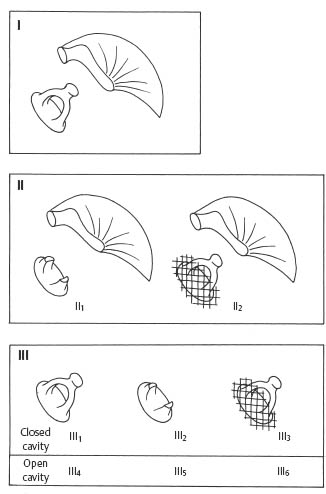
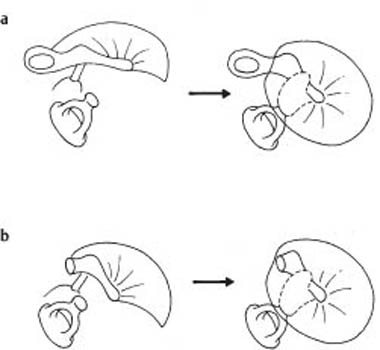
 Local anesthesia.
Local anesthesia. Endaural approach.
Endaural approach. Preservation of chorda tympani. Modification of autograft incus (notch for stapes in short process, notch for malleus on articular surface).
Preservation of chorda tympani. Modification of autograft incus (notch for stapes in short process, notch for malleus on articular surface). Interposition of modified incus.
Interposition of modified incus. Stabilization of interposed incus with chorda tympani.
Stabilization of interposed incus with chorda tympani.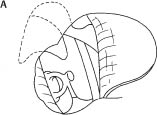
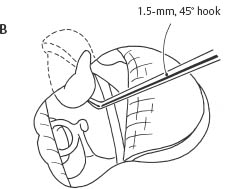
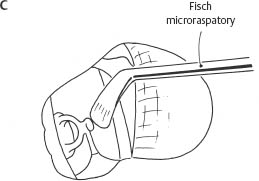
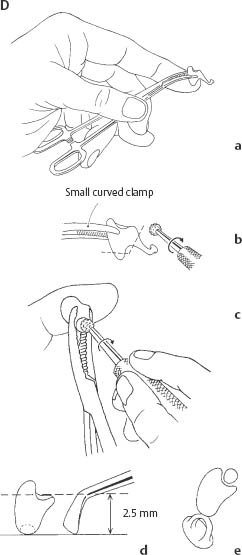
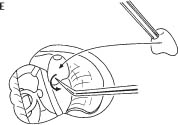



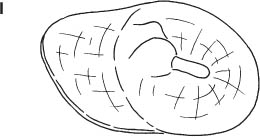

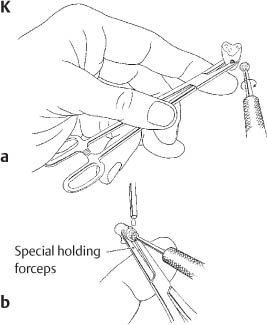
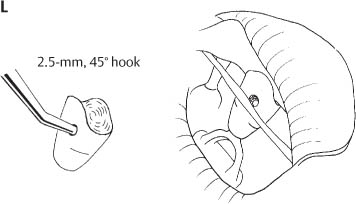
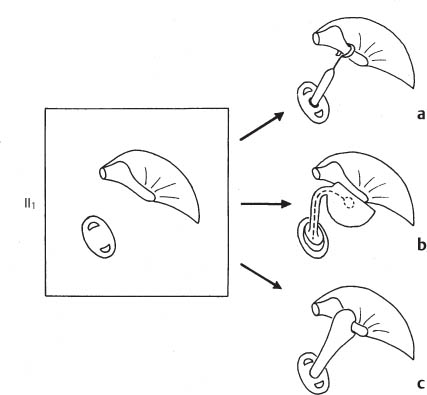
 Local or general anesthesia.
Local or general anesthesia. Endaural approach.
Endaural approach. Tympanomeatal flap elevated from the superior third of handle and lateral process of malleus.
Tympanomeatal flap elevated from the superior third of handle and lateral process of malleus. Manual perforation of mobile footplate.
Manual perforation of mobile footplate. 0.4-mm TSP attached to superior malleus handle and placed in vestibule.
0.4-mm TSP attached to superior malleus handle and placed in vestibule. Sealing of stapedotomy opening with connective tissue, venous blood, and fibrin glue.
Sealing of stapedotomy opening with connective tissue, venous blood, and fibrin glue. Wound closure, packing, and postoperative care as for stapedotomy.
Wound closure, packing, and postoperative care as for stapedotomy.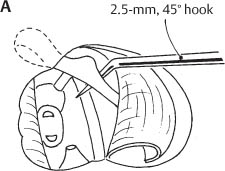
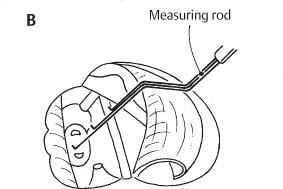
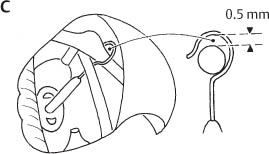


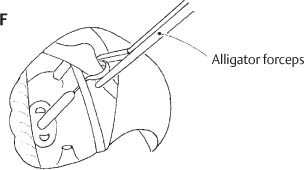
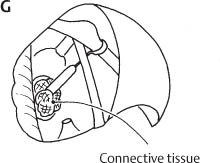
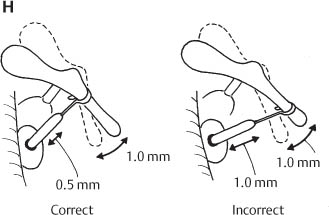
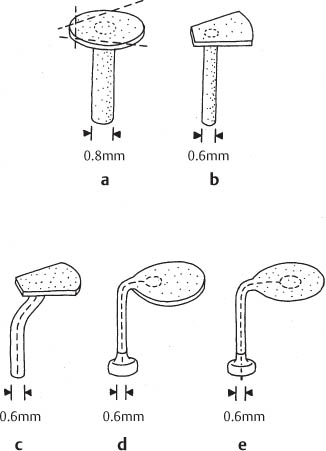
 Local anesthesia.
Local anesthesia. Tympanomeatal flap as for stapedotomy.
Tympanomeatal flap as for stapedotomy. Removal of air from Spandrel’s Polycel casing.
Removal of air from Spandrel’s Polycel casing. Assembly of Spandrel shaft and shoe.
Assembly of Spandrel shaft and shoe. Transportation of Spandrel with microsuction tube.
Transportation of Spandrel with microsuction tube. Adaptation of Spandrel’s shoe with spike on center of footplate.
Adaptation of Spandrel’s shoe with spike on center of footplate. Rotation of Spandrel head beneath center of drum.
Rotation of Spandrel head beneath center of drum. Closure and packing as for stapedotomy.
Closure and packing as for stapedotomy.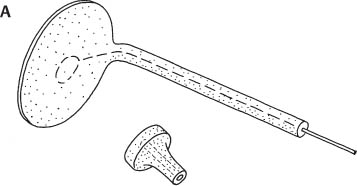
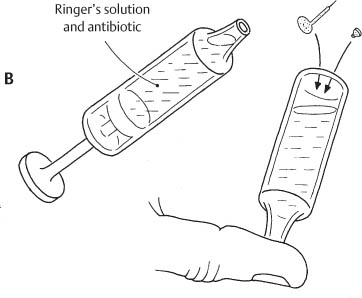
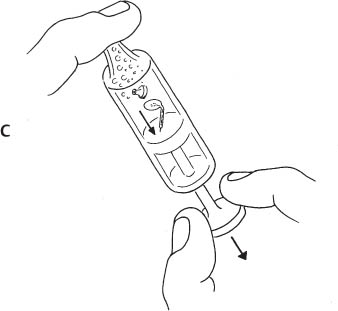
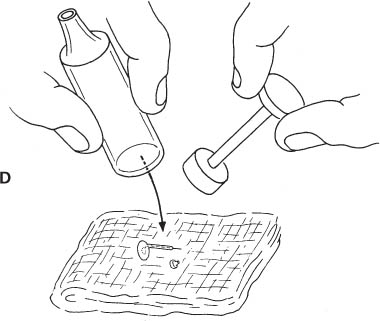


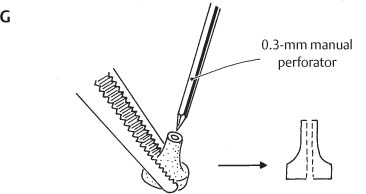
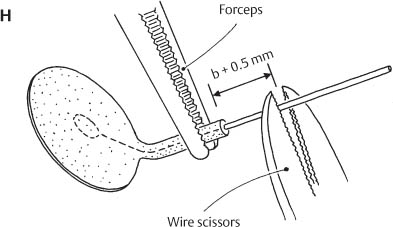
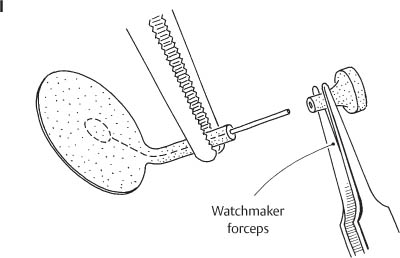
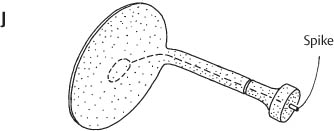
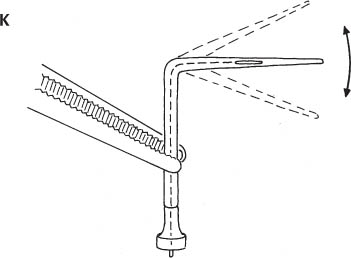


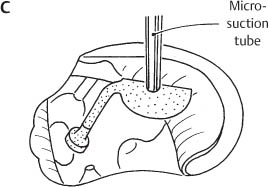
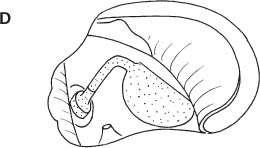
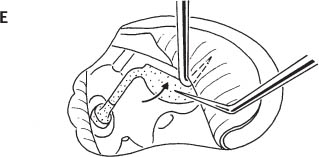
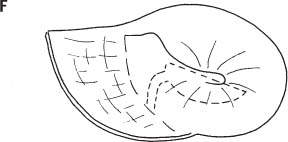
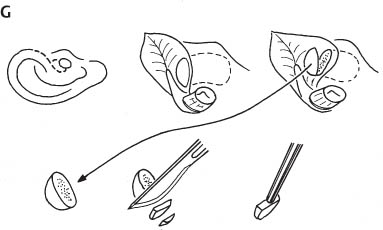

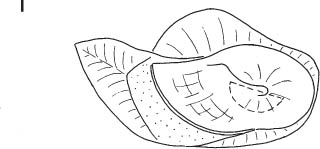
 Local or general anesthesia.
Local or general anesthesia. Tympanomeatal flap as for MS.
Tympanomeatal flap as for MS. Shaping of ossicle with diamond burr.
Shaping of ossicle with diamond burr. Fixation of ossicle on stapes footplate with connective tissue and fibrin glue.
Fixation of ossicle on stapes footplate with connective tissue and fibrin glue. Fixation of ossicle on malleus handle with carved notch.
Fixation of ossicle on malleus handle with carved notch.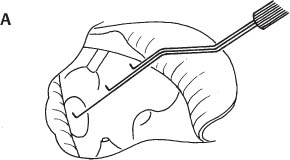
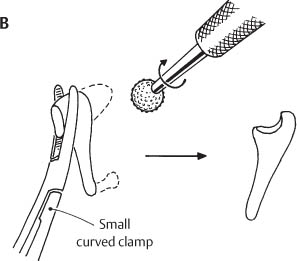
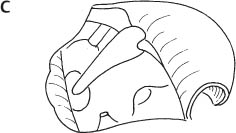
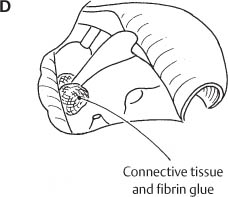
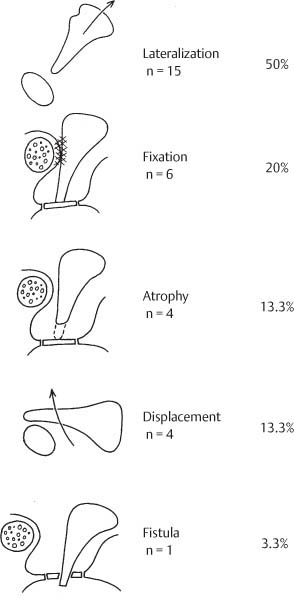
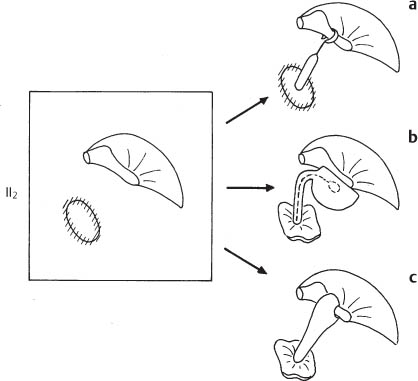
 Local or general anesthesia.
Local or general anesthesia. Endaural approach.
Endaural approach. Total stapedectomy.
Total stapedectomy. Covering of the oval window with pressed tragal perichondrium.
Covering of the oval window with pressed tragal perichondrium. Use of Spandrel with spike but without shoe.
Use of Spandrel with spike but without shoe. Use of FTT without shoe but with cartilage disc.
Use of FTT without shoe but with cartilage disc.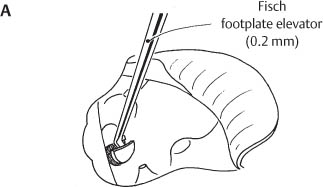
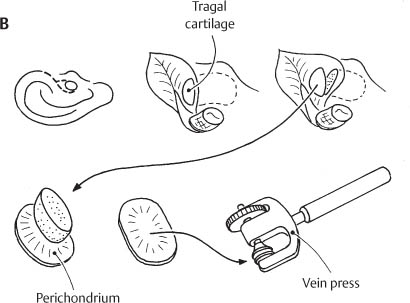

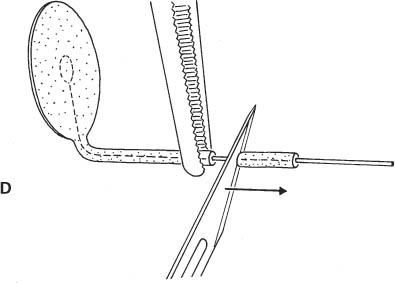
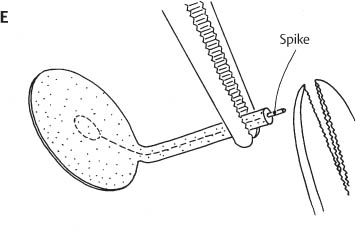
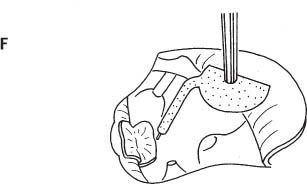
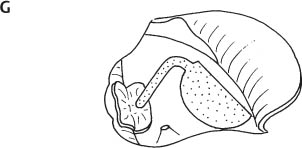
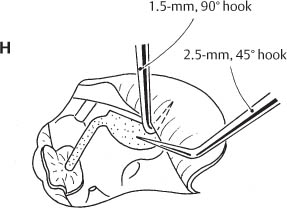
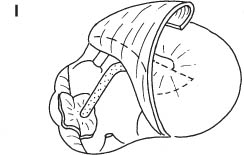
 Local or general anesthesia.
Local or general anesthesia. Total stapedectomy.
Total stapedectomy. Modified autograft incus interposed between the oval window and malleus handle.
Modified autograft incus interposed between the oval window and malleus handle.